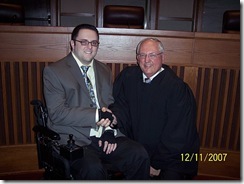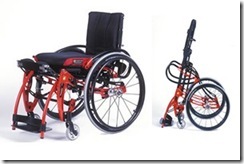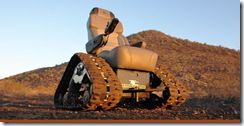In every lifetime there are those moments or events where you just want everything to go perfectly as planned. These typically include things like graduation day, a first date with someone you’re crazy about, your marriage proposal, your wedding day, a job interview, a public speaking event, etc. For me, getting sworn in as an attorney was one of those big deal life events where I hoped things would fall right into place. Three years ago today, on December 11, 2007, I was sworn in as a licensed Minnesota attorney in front of the Minnesota Supreme Court. It was a proud day for both me and my family. Not only was it the culmination of four tough years of law school and the passing of the bar exam, but a pretty cool legal right of passage to boot.
But unfortunately having it all go off without a hitch wasn’t in the cards that day. Far from it as it were. Because when you live my lifestyle inexplicable and unexpected things related to my spinal cord injury and/or wheelchair tend to spring up at the most inopportune times. Thus December 11, 2007 became “one of those days” at the worst time possible.
The ceremony was scheduled to begin sharply at 3 pm in the main courtroom of the Minnesota Supreme Court building, which was pretty iconic stuff. I was actually supposed arrive at least fifteen minutes early to sign the requisite paperwork and get situated. The first mistake that I made was having my family drive past the court building in St. Paul to meet me at my apartment in Minneapolis first. I needed help with my suit and tie and they hit traffic, so we didn’t end up parking by the courthouse until 2:45 when I was already supposed to be inside. As a result, I was feeling really rushed.
On top of that I had never been to the Minnesota Supreme Court building before so I didn’t know where I was going or where the front entrance was. When you use a wheelchair and the overall accessibility of a building is in question a trick of the trade is to follow the blue wheelchair access/disability signs. Almost all of the time those signs lead the way to the wheelchair accessible entrance. So as I was hauling ass down the sidewalk of what turned out to be the side of the building I saw a disability access sign that pointed to a certain entrance. “This must be it,” I thought. As I approached it and hit the automatic door button nothing happened. We grabbed the handle to pull the door open and it was locked. Next to the door was one of those talk boxes with a red button. So I pushed the button, someone answered, and I said that I used a wheelchair and needed to get in but the door was locked. They buzzed me in. At the least, it was an annoyance that I could have done without on my way into the building.
Now at that point it didn’t make much sense that that was how I would have to enter the building to get to my ceremony. Why would I have to use a small side entrance that had its door locked during the middle of the day? But again, I was in a rush and I was going on past experience and instinct. After all, in the preceding eleven years of using a wheelchair (at that point) I’d already jumped through way crazier hoops just to enter buildings, and with that court building being a bit older it certainly wasn’t out of the realm of possibility that I needed to take an equally roundabout route. So I proceeded.
What made even less sense though was when I got inside the door and immediately found myself at the top of a staircase. “What the f---?” I thought to myself. I looked to my right and there was a wooden closet looking door with the disability access symbol on it so I opened it up to fund a metal dumbwaiter style elevator-lift big enough to fit one wheelchair. It was exactly like the kind I had to use in my university bookstore to get to the lower floor where the books actually were. I can’t begin to explain how hard it was trying to catch the eye of some college cuties when I had to get in a metal box that very obnoxiously went ZZZZZZZZGGGGGGGGHHHHHHHH for a good thirty seconds before it reached the bottom, and vice versa. Very embarrassing.
Now at this point I definitely should have just turned around, gone back out the door I had just come through, and gone down the sidewalk again because there was no way that was the accessible entrance that would take me to the main courtroom of the Minnesota Supreme Court. And as it turns out it wasn’t. But fueled by the fact that I was running late and without giving it a second thought I launched myself into the “elevator,” closed the door behind me, and pressed the down button.
It was pretty much the instant that I hit the button that I had a “I probably shouldn’t be doing this” bad feeling, and sure enough the lift went down about four inches and crapped out. I hit the down button again, nothing. I hit the up button, nothing. Tried them both again, nothing. The emergency button didn’t work either. Great. Already late for what was arguably the biggest event of my life up until that point and I was stuck in some crappy elevator lift I should have known better to not even use in the first place.
Meanwhile, my family was on the floor below waiting for me to come down. Finally, my mom yells out something like, “Are you coming down or what?” I told her I was stuck. I think the response that came back was to try hitting the down button again. I yelled back that I was stuck stuck, as in no buttons worked and I couldn’t move. As everyone came back to the top to see the situation first hand I heard a lady walk in behind me and ask what was going on. My mom told her that I was stuck in the lift. Then she replied, “Oh that thing hasn’t worked for years” and went on her way. well for crying out loud, had ANYBODY thought about posting an “out of order’ sign or something? Unbelievable.
So my now brother-in-law went off to find some maintenance guy to help us and my dad went to let somebody in charge know that I was going to be a little late to the ceremony and to see if they could maybe hold things up for me given the unique circumstances. The longer I was stuck the more pissed off I got. Of all days to get stuck in a broken elevator lift was the one and only day that I would become an official lawyer. What were the odds?
After not too long a wait, albeit by the same token way longer than I’d hoped, the maintenance guy finally showed up. He reiterated that the lift had been broken for quite while. Thanks a pant load for the non-forewarning man! Since he couldn’t get it working again the only solution was to try and pull me out. I couldn’t back out because four inches is too high a threshold to wheel over going either frontwards or backwards with my chair. Also making it no small feat was the fact that my body weight plus my chair weight tops out at around 400 lbs. But between the two of them they were able to lift my back end high enough so I could control my back wheels to help get me back on level ground. Every fiber of my being wanted to bitch him out for not posting some sort of out of order sign, especially since his reaction to me more than implied that it was my fault for getting stuck in the first place, but more than anything I was just relieved to get out and I had to really get moving to get inside.
Down the sidewalk we went again. I got to the corner, hung a left, went about twenty more yards and, duh, there was the main entrance. My dad assured me that they were holding things up for me so that put me at ease a little bit, but my face was red from frustration, my shirt and tie were a little crooked, and in general I felt out of sorts. After I took a moment to straighten out and collect myself in what felt like the longest elevator ride up one floor in history I was finally outside the courtroom entrance.
As I rolled in the doors half embarrassed for being late and half relieved to finally have made it I found myself on the observation level of the courtroom while all the other soon-to-be attorneys attending the ceremony were down on the courtroom floor level. To get down there you had to go through a small swinging door and down a few stairs. So as it turned out although I finally made to the courtroom I still hadn’t actually made it. As all eyes were on me wondering what I was going to do next a courtroom shepherd asked me if I wanted to go down there to join the group. Relieved to finally be in the room but frustrated that the saga continued I said, “That’s ok.” But she assured me that it was just as easy as taking a ramp down the outside of the courtroom to get down there.
So I followed her to the left side of the courtroom where she held open a door for me, told me to go to the bottom of the ramp, and that she would go around and open it up for me. Then I sat there facing the closed door for who knows how long until I heard the door behind me open up again and a voice say, “I’m sorry, that’s not the right way, we actually have to go around to the other side.” Because there wasn’t enough room to turn my chair around I had to back all the way out instead.
As I followed her to the other side it started to feel like I was in the middle of one of those funny ha ha room to room chase sequences like you see on “Scooby Doo” or other similarly replicated comedy montages. By the time I popped out at the bottom of the ramp and entered the courtroom floor the Justice charged with swearing us in was in the middle of his “This is a time-honored profession…” speech. So I was already embarrassed interrupting things, especially with a loud puttering power wheelchair that makes a clickety clack noise whenever it goes in and out of gear. All the other new attorneys were sitting along the outer rim of the courtroom floor and the only spot available was on my end (thankfully) between a lady who pulled her chair over to clear me some room and the courtroom’s witness box. But in order to get myself into position I had to roll through a very tight space between the witness box and a brass bottomed flag stand, and as I squeezed through it my brand new rubber wheelchair tires let out a very loud and mortifying SSQQUUEEKK as they rubbed against the brass, which was essentially the cherry on top of an overall sundae of suck.
Once again I tried to collect myself as coolly and quickly as possible and tried to enjoy the rest of the ceremony as much as I could by putting all of the BS I had just gone through behind me. Obviously, it was a cool thing to be a part of and when I raised my hand and finally got sworn in as a real licensed Minnesota attorney it felt awesome.
After the ceremony everyone lined up to shake the Justice’s hand, chat with him, and get a picture. After everything that I had just been through I was pretty much ready to get the hell out of there and go to dinner, because I don’t remember desperately wanting a drink more at any point in my life. But my parents kind of insisted that we wait around and so we could get a picture with the Justice as well because it could be a something that I would regret not doing someday.
I’m glad I did too because I was last in line so I got some pretty unique one on one time with him. He was actually the Justice that came and spoke in my Criminal Procedure class the fall semester before. That night in class he pretended to punch me in the face while he lead a mini “What is justice?” lecture so I certainly didn’t forget him. When I reminded him of all that he claimed to have recognized me when I rolled into the courtroom. The thing I really thought was cool about him was that he got down on one knee so that he was more on my level to chat with me and take some pictures.

Then the unexpected occurred. With me that day were my parents, my sister, my now brother-in-law (aka my brolaw), and my baby nephew who was eight months old at the time. At some point in true father/grandfather’s pride fashion my dad mentioned to the Justice that my nephew had my name for his middle name. So after that the Justice kept referring to my nephew as “little Shawn.” Then out of nowhere he said, “You know what would make a great picture? If you took little Shawn up above and set him on the court bench.” So my sister and brolaw took my nephew around and sat him down on that Justice’s spot on the supreme court bench and we took a few pictures. Being a Minnesota law historian he then declared that my nephew was the first baby in the history of the Minnesota Supreme Court to sit on the bench. It was pretty awesome. And as it turned out it ended up being a pretty unique and fitting postscript to the whole crazy event.
So as much as I try to plan ahead and play all the angles to prevent wild things from happening, a lot of times the unexpected still wins out and it can be downright tumultuous like it was in this case. But in the end all that matters is that I survived the crappy elevator fiasco, I made it inside for the ceremony better late than never, I still became an officially licensed Minnesota attorney, and in the process we made a little bit of Minnesota Supreme Court history as well. And ultimately, I have a much better story to tell because of it. It also goes without saying that I might not ever be able to look at my attorney’s license card or see the words “Minnesota Supreme Court” and not think about that day.








